Different Ways of Taking Food
Chapter 2: Nutrition in Animals
Different ways of taking food
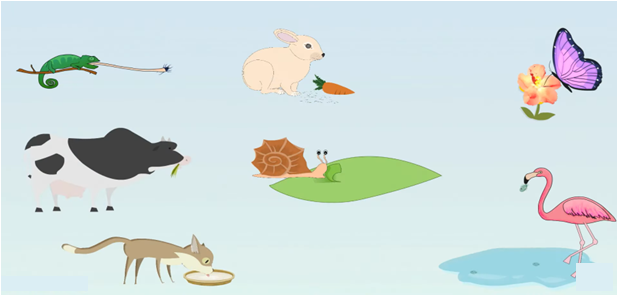
Food is required by all the organisms. The animal nutrition includes the nutrient requirements, the mode of food intake, and the utilization of food in the body. The intake of food is called ingestion. The ingested food is broken down into simpler substances in the process called digestion. The mode of food intake varies in different organisms. Let us have a look at the different ways of taking food by the organisms.
Digestion in Humans
- Books Name
- CBSE Class 7 Science Book
- Publication
- Param Publication
- Course
- CBSE Class 7
- Subject
- Science
DIGESTION IN HUMAN BEINGS
Digestion is the process in which the insoluble complex food material is broken down by physical and chemical methods into simple soluble food materials. In this process
(I) Carbohydrates are converted into glucose.
(II) Proteins are converted into Amino Acids.
(III) Lipids are converted into fatty acid and glycerol.
Types of Digestion
(A) Intracellular digestion:- When digestion takes place inside the cells. e.g. Amoeba, Paramecium, Euglena, Sponges.
(B) Extracellular digestion:- When digestion takes place outside the cells. e.g. Earthworm, Starfish and Human beings etc. Human beings are omnivorous feed on different parts of the plant like root, shoot, fruits, seeds and also on animal products like eggs, meat and milk.
• The Human digestive system divided into two parts.
(A) Alimentary Canal:- It has following parts

4. Oesophagus or food pipe
5. Stomach.

![]()
(B) Digestive Glands:-
1. Liver
2. Pancreas
3. Salivary gland
4. Gall bladder - Absent in rat
5. Gastric gland in stomach
6. Intestinal gland in intestine
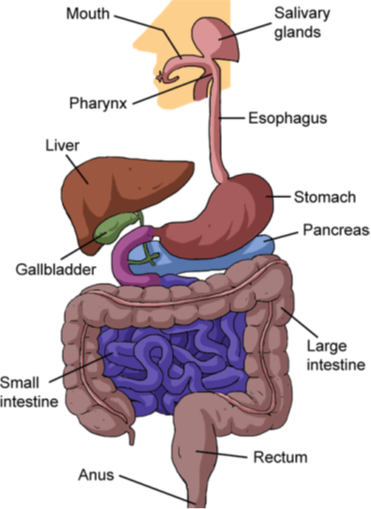
In human the alimentary canal is about 9 m long tube. The small intestine is about 6 m and large intestine about 1.5 m long.
Mouth and Buccal Cavity:-
Food is taken into the alimentary canal through mouth. It is called ingestion. Mouth is surrounded by lips. The food is chewed with the help of teeth, tasted with the help of tongue and moistened with saliva.
Tongue:- It is a muscular organ found in buccal cavity. It is free in front but posterior region is attached with a structure known as Frenulum.
It contain two important structures
1. Papillae 2. Taste buds
Papillae has taste buds for identification of taste. Sweet, Sour, Salty, Bitter.
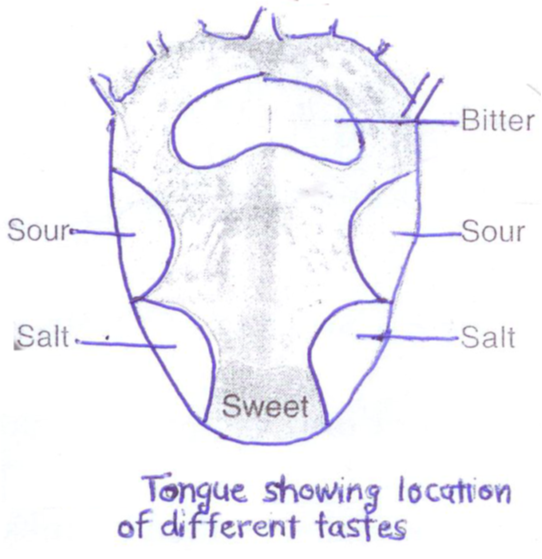
Function of the tongue:-
1. Essential for swallowing and mastication.
2. Essential for talking & speech
3. Essential for taste the food.
4. For mixing of saliva with food.
Teeth:- The arrangement of teeths on upper and lower jaw is known as dentition. Teeth are rooted in sockets in the gums. Human has Heterodont dentition. There are four types of teeths.
1. Incisors - For cutting
2. Canines - For piercing and tearing
![]()
Dental formula:-
![]()
![]()
![]()
So Total No. of teeth in Human being is 32 in a adult.
- The Ist set of teeth grows during infancy and they fall off at the age between 6 - 8 years. These are called milk teeth. Their number is about 20.
- The second set of teeth that replaces them are called permanent teeth, which last through out life or fall off during old age. The number of permanent teeth are 28 including 8 molars.
Structure of tooth:- A typical tooth is made up of three parts.
(A) Crown
(B) Neck
(C) Root.
Crown is externally covered by enamel whereas neck & root is covered by cement. Enamel is formed by Ameloblast cells.
The main part of tooth is dentine formed by odontoblast cells and have a pulp cavity. Pulp cavity is living part of tooth because it has blood supply and nerve supply.
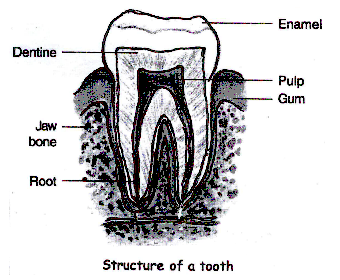
Tooth Decay:- If we do not clean our teeth after eating, they turn yellowish because a yellowish and sticky film formed from food particles, saliva and bacteria. This is called plaque.
The bacteria in the plaque convert sugar and starch of food into acids. This acid dissolve the enamel and damage the teeth. This is called tooth decay. This leads to the formation of cavity in the tooth & than tooth loss. Chocolates, sweets and cold drinks are responsible for tooth decay and tooth loss.
Digestion in Humans
Digestion in humans
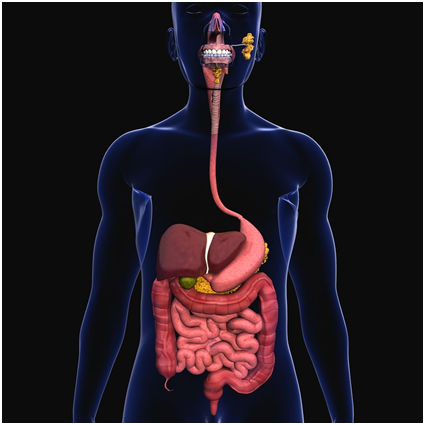
The human digestive system consists of the gastrointestinal tract plus the accessory organs of digestion (the tongue, salivary glands, pancreas, liver, and gallbladder). Digestion involves the breakdown of food into smaller and smaller components, until they can be absorbed and assimilated into the body.
The process of digestion has three stages: the cephalic phase, the gastric phase, and the intestinal phase.The first stage, the cephalic phase of digestion, begins with secretions from gastric glands in response to the sight and smell of food.The second stage of digestion begins in the stomach with the gastric phase.
The third stage begins in the duodenum with the intestinal phase, where partially digested food is mixed with a number of enzymes produced by the pancreas.
Digestion in Grass-Eating Animals
Digestion in grass eating animals
The animals (such as cow) which eat grass have a special stomach to digest the tough cellulose carbohydrate present in grass. The stomach of a cow is large and consists of four compartments (or four chambers).The first compartment of a cow’s stomach is the biggest and it is called rumen.
When cow eats grass as food while grazing, it does net chew it completely (because it has no time for it). The cow swallows the grass quickly with little chewing and stores it in the rumen (which is the first compartment of stomach).
The rumen contains cellulose digesting bacteria. The bacteria present in the rumen of a cow start to digest cellulose carbohydrate present in grass food. Thus, the grass is partially digested in the rumen. The partially digested food (or partially digested grass) in the rumen of a cow is called cud.
Feeding and Digestion In Amoeba.
- Books Name
- CBSE Class 7 Science Book
- Publication
- Param Publication
- Course
- CBSE Class 7
- Subject
- Science
NUTRITION IN AMOEBA
Amoeba feeds on minute microscopic organisms or bacteria. It is a microscopic single celled organisms. The mode of Nutrition in Amoeba is Holozoic in which solid food is engulfed in following steps:
Ingestion:- When Amoeba comes in contact with prey, the finger like Pseudopodia surrounds it and engulf it. This food is trapped in a food vacuole. This food vacuole now moves into the cytoplasm.
Digestion:- Food in the food vacuole is digested by digestive enzymes secreted by cytoplasm. The reaction in the food vacuole is first acidic due to HCl and than becomes alkaline. In acidic medium prey is killed. In alkaline medium the prey is digested.
Absorption:- Digested food now diffuses into the cytoplasm and used for energy growth and repair.
Egestion :- Now food vacuoles moves to the body surface and than ruptures, so undigested food expelled out of the body at any point because amoeba has no Anus.

Feeding and Digestion In Amoeba.
Feeding and digestive in Amoeba
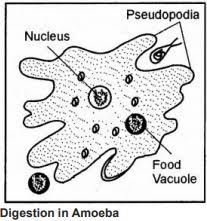
The process of digestion in amoeba is very simple and short. Amoeba don’t have mouth and digestive system .Then don’t u have a question , How they eat food ,digest food and excrete food .Amoeba eats microscope ,after it has the feeling of near by food.It extend its pseudopodia all over the food and consume it .Then the food enters into the food vacuole which contain some digestive juice .The action done by food vacuole on food convert it into smooth substance .The digested food used to grow , reproduction , etc by amoeba.
Fibre to fabric
Animal skin and leaves were utilised to cover the body of early men. However, as time went by, humans perfected the art of extracting fibres from plants and animals. Subsequently, humans began weaving them into garments. Since the prehistoric era, there has been continuous change, advancements, and modifications in all the basic needs of human beings, including food, shelter, and clothing to make our lives comfortable.Fibres are extremely long, flexible, and thin thread-like structures of a natural or artificial substance. Yarn is made from fibres. Furthermore, these yarns are combined to form different types of fabrics. Fibres are classified into two types based on origin: natural fibres and synthetic fibre.


 Grow Career Publication
Grow Career Publication
 Param Publication
Param Publication
